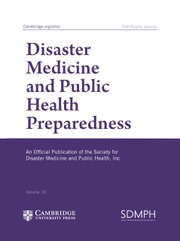Article contents
Disaster Knowledge, Skills, and Preparedness among Emergency Medical Services in Saudi Arabia
Published online by Cambridge University Press: 30 October 2024
Abstract
Emergency Medical Services (EMS) workers are critical to effective disaster response. Therefore, it is important to understand their knowledge, skills, and preparedness for disasters. This study investigated factors influencing EMS workers’ disaster knowledge, skills, and preparedness in the Saudi Arabian context. The study also sought to identify challenges to disaster preparedness among Saudi Arabian EMS workers.
A descriptive cross-sectional survey using The Disaster Preparedness Evaluation Tool was distributed to EMS workers in military and government hospitals across 3 Saudi Arabian cities. Responses were recorded on a 6-point Likert scale where higher scores indicated higher knowledge, skills, or preparedness. The results were analysed using descriptive and inferential statistical analysis.
272EMS workers participated in this study. EMS workers reported a moderate level of knowledge (3.56), skills (3.44), and preparedness (3.73) for disasters. Despite this, EMS workers reported a high level of involvement in regular disaster drills (M = 4.24, SD = 1.274) and a strong interest in further disaster education opportunities (M = 5.43, SD = 1.121). Participants also reported a high skill level with the triage principles used in their workplace during a disaster (M = 4.06, SD = 1.218). The study findings revealed a significant positive correlation between disaster preparedness levels and age, years of experience, education level, and the facility worked in.
EMS workers have moderate disaster knowledge, skills, and preparedness levels. Knowledge, skill, and preparedness have a significant relationship on the EMS workers’ demographics. These findings demonstrate the need to invest in preparing Saudi Arabian EMS workers to effectively respond to bioterrorism disasters.
- Type
- Original Research
- Information
- Copyright
- © The Author(s), 2024. Published by Cambridge University Press on behalf of Society for Disaster Medicine and Public Health, Inc
References
- 1
- Cited by


